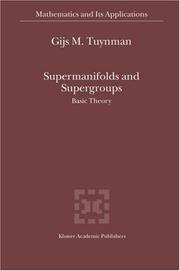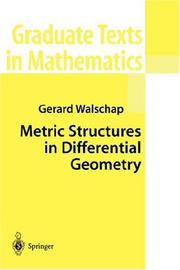| Listing 1 - 8 of 8 |
Sort by
|
Book
ISBN: 8524401974 Year: 2004 Publisher: Rio de Janeiro : Instituto de matemática pura e aplicada [Rio de Janeiro][I.M.P.A.],
Abstract | Keywords | Export | Availability | Bookmark
 Loading...
Loading...Choose an application
- Reference Manager
- EndNote
- RefWorks (Direct export to RefWorks)
Book
ISSN: 10529233 ISBN: 1571461159 9781571461155 Year: 2004 Volume: 9 Publisher: Somerville (Mass.): International press,
Abstract | Keywords | Export | Availability | Bookmark
 Loading...
Loading...Choose an application
- Reference Manager
- EndNote
- RefWorks (Direct export to RefWorks)
Laplacian operator. --- Geometry, Differential. --- Eigenvalues. --- Géométrie différentielle --- Laplacien --- Valeurs propres --- Géométrie différentielle. --- Laplacien. --- Valeurs propres.
Book
Year: 2004 Publisher: Palermo : Circolo matematico di Palermo,
Abstract | Keywords | Export | Availability | Bookmark
 Loading...
Loading...Choose an application
- Reference Manager
- EndNote
- RefWorks (Direct export to RefWorks)
Mathematiques --- Geometrie differentielle --- Physique theorique --- Colloque --- Colloque --- Colloque

ISBN: 0821835181 Year: 2004 Publisher: Providence (R.I.): American Mathematical Society
Abstract | Keywords | Export | Availability | Bookmark
 Loading...
Loading...Choose an application
- Reference Manager
- EndNote
- RefWorks (Direct export to RefWorks)
Functional analysis --- Differential geometry. Global analysis --- Noncommutative differential geometry. --- Global differential geometry. --- Géométrie différentielle non commutative. --- Géométrie différentielle globale. --- Global differential geometry --- Noncommutative differential geometry --- Differential geometry, Noncommutative --- Geometry, Noncommutative differential --- Non-commutative differential geometry --- Infinite-dimensional manifolds --- Operator algebras --- Geometry, Differential

ISSN: 09380396 ISBN: 9783540210191 3540210199 3642059074 3662064049 Year: 2004 Volume: 87 Publisher: Berlin: Springer,
Abstract | Keywords | Export | Availability | Bookmark
 Loading...
Loading...Choose an application
- Reference Manager
- EndNote
- RefWorks (Direct export to RefWorks)
This book presents some facts and methods of the Mathematical Control Theory treated from the geometric point of view. The book is mainly based on graduate courses given by the first coauthor in the years 2000-2001 at the International School for Advanced Studies, Trieste, Italy. Mathematical prerequisites are reduced to standard courses of Analysis and Linear Algebra plus some basic Real and Functional Analysis. No preliminary knowledge of Control Theory or Differential Geometry is required. What this book is about? The classical deterministic physical world is described by smooth dynamical systems: the future in such a system is com pletely determined by the initial conditions. Moreover, the near future changes smoothly with the initial data. If we leave room for "free will" in this fatalistic world, then we come to control systems. We do so by allowing certain param eters of the dynamical system to change freely at every instant of time. That is what we routinely do in real life with our body, car, cooker, as well as with aircraft, technological processes etc. We try to control all these dynamical systems! Smooth dynamical systems are governed by differential equations. In this book we deal only with finite dimensional systems: they are governed by ordi nary differential equations on finite dimensional smooth manifolds. A control system for us is thus a family of ordinary differential equations. The family is parametrized by control parameters.
Mathematical optimization --- Geometry, Differential --- Differentiable dynamical systems --- Commande, théorie de la --- Optimisation mathématique --- Géométrie différentielle --- Dynamique différentiable --- Control theory --- Control theory. --- Differentiable dynamical systems. --- Geometry, Differential. --- Mathematical optimization. --- Commande, Théorie de la. --- Dynamique différentiable. --- Géométrie différentielle. --- Optimisation mathématique. --- System theory. --- Systems Theory, Control. --- Systems, Theory of --- Systems science --- Science --- Philosophy

ISBN: 9781402022968 1402022964 9781402022975 1402022972 1281069701 9786611069704 Year: 2004 Publisher: Dordrecht ; Boston : Kluwer Academic Publishers,
Abstract | Keywords | Export | Availability | Bookmark
 Loading...
Loading...Choose an application
- Reference Manager
- EndNote
- RefWorks (Direct export to RefWorks)
Supermanifolds and Supergroups explains the basic ingredients of super manifolds and super Lie groups. It starts with super linear algebra and follows with a treatment of super smooth functions and the basic definition of a super manifold. When discussing the tangent bundle, integration of vector fields is treated as well as the machinery of differential forms. For super Lie groups the standard results are shown, including the construction of a super Lie group for any super Lie algebra. The last chapter is entirely devoted to super connections. The book requires standard undergraduate knowledge on super differential geometry and super Lie groups.
Global differential geometry. --- Supermanifolds (Mathematics) --- Superalgebras. --- Géométrie différentielle globale --- Supervariétés (Mathématiques) --- Superalgèbres --- Supermanifolds (Mathematics). --- Global differential geometry --- Superalgebras --- Geometry --- Mathematics --- Physical Sciences & Mathematics --- Nonassociative algebras --- Differentiable manifolds --- Geometry, Differential --- Superalgèbres. --- Superalgèbres --- Analyse sur une variété

ISBN: 038720430X Year: 2004 Publisher: New York (N.Y.) Springer
Abstract | Keywords | Export | Availability | Bookmark
 Loading...
Loading...Choose an application
- Reference Manager
- EndNote
- RefWorks (Direct export to RefWorks)
This text is an introduction to the theory of differentiable manifolds and fiber bundles. The only requisites are a solid background in calculus and linear algebra, together with some basic point-set topology. The first chapter provides a comprehensive overview of differentiable manifolds. The following two chapters are devoted to fiber bundles and homotopy theory of fibrations. Vector bundles have been emphasized, although principal bundles are also discussed in detail. The last three chapters study bundles from the point of view of metric differential geometry: Euclidean bundles, Riemannian connections, curvature, and Chern-Weil theory are discussed, including the Pontrjagin, Euler, and Chern characteristic classes of a vector bundle. These concepts are illustrated in detail for bundles over spheres. Chapter 5, with its focus on the tangent bundle, also serves as a basic introduction to Riemannian geometry in the large. This book can be used for a one-semester course on manifolds or bundles, or a two-semester course in differential geometry. Gerard Walschap is Professor of Mathematics at the University of Oklahoma where he developed this book for a series of graduate courses he has taught over the past few years.
Geometry, Differential --- Fiber bundles (Mathematics) --- Differentiable manifolds --- Characteristic classes --- Géométrie différentielle --- Faisceaux fibrés (Mathématiques) --- Variétés différentiables --- Classes caractéristiques --- Differential geometry --- Geometry, Differential. --- Géométrie différentielle --- Faisceaux fibrés (Mathématiques) --- Variétés différentiables --- Classes caractéristiques

ISBN: 9780521829601 0521829607 0521536456 9780511607066 9780521536455 9781139129091 1139129090 0511261675 9780511261671 0511607067 1107160421 113963710X 1283329611 1139134124 9786613329615 0511263295 0511566573 0511264100 Year: 2004 Publisher: Cambridge : Cambridge University Press,
Abstract | Keywords | Export | Availability | Bookmark
 Loading...
Loading...Choose an application
- Reference Manager
- EndNote
- RefWorks (Direct export to RefWorks)
This book, first published in 2004, provides an introduction to the major mathematical structures used in physics today. It covers the concepts and techniques needed for topics such as group theory, Lie algebras, topology, Hilbert space and differential geometry. Important theories of physics such as classical and quantum mechanics, thermodynamics, and special and general relativity are also developed in detail, and presented in the appropriate mathematical language. The book is suitable for advanced undergraduate and beginning graduate students in mathematical and theoretical physics, as well as applied mathematics. It includes numerous exercises and worked examples, to test the reader's understanding of the various concepts, as well as extending the themes covered in the main text. The only prerequisites are elementary calculus and linear algebra. No prior knowledge of group theory, abstract vector spaces or topology is required.
Mathematical physics. --- Physique mathématique --- Mathematical physics --- 51-7 --- 51-7 Mathematical studies and methods in other sciences. Scientific mathematics. Actuarial mathematics. Biometrics. Econometrics etc. --- Mathematical studies and methods in other sciences. Scientific mathematics. Actuarial mathematics. Biometrics. Econometrics etc. --- Physical mathematics --- Physics --- Mathematical studies and methods in other sciences. Scientific mathematics. Actuarial mathematics. Biometrics. Econometrics etc --- Mathematics --- Geometry, Differential --- Hilbert space --- Physique mathématique --- Géométrie différentielle --- Hilbert, Espaces de --- Physique mathématique. --- Géométrie différentielle. --- Hilbert, Espaces de.
| Listing 1 - 8 of 8 |
Sort by
|

 Search
Search Feedback
Feedback About
About Help
Help News
News